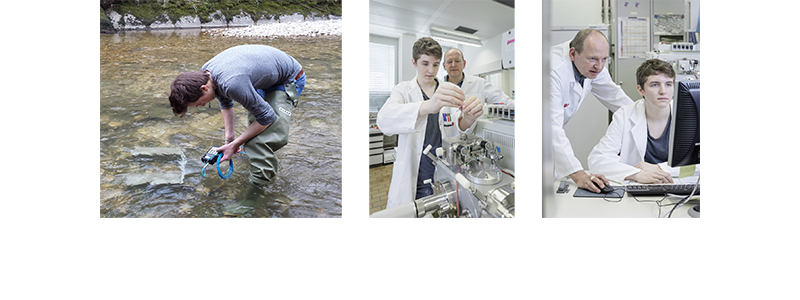Organic Analysis: Pollutants in Materials
The list of persistent organic pollutants (POPs) regulated under the Stockholm Convention is growing for compounds fulfilling the criteria on persistence, toxicity, long-range transport- and bio-accumulation. Some of these POPs have been produced at large scales (>10'000 t/y) and were distributed globally. With mass spectrometric methods, they can be detected in materials, food, consumable products, livestock.
Reactive Organic Pollutants (ROP's)
Short-chain chlorinated paraffins (SCCPs) are listed as persistent organic pollutants (POPs) under the Stockholm Convention. Such substances are toxic, bioaccumulating, transported over long distances and degrade slowly in the environment. Certain bacterial strains of the Sphingomonadacea family are able to degrade POPs, such as hexachlorocyclohexanes (HCHs) and hexabromocyclododecanes (HBCDs).
The haloalkane dehalogenase LinB, expressed in certain Sphingomonadacea, is able to catalyze the transformation of haloalkanes to hydroxylated compounds. Therefore, LinB is a promising candidate for conversion of SCCPs. Hence, a mixture of chlorinated tridecanes was exposed in vitro to LinB, which was obtained through heterologous expression in Escherichia coli. Liquid chromatography mass spectrometry (LC-MS) was used to analyze chlorinated tridecanes and their transformation products. A chloride-enhanced soft ionization method, which favors the formation of chloride adducts [M+Cl]- without fragmentation, was applied.
Mathematical deconvolution was used to distinguish interfering mass spectra of paraffinic, mono-olefinic and di-olefinic compounds. Several mono- and di-hydroxylated products including paraffinic, mono-olefinic and di-olefinic compounds were found after LinB exposure. Mono- (rt = 5.9–6.9 min) and di-hydroxylated (rt = 3.2–4.5 min) compounds were separated from starting material (rt = 7.7–8.5 min) by reversed phase LC. Chlorination degrees of chlorinated tridecanes increased during LinB-exposure from nCl = 8.80 to 9.07, indicating a preferential transformation of lower chlorinated (Cl<9) tridecanes. Thus, LinB indeed catalyzed a dehalohydroxylation of chlorinated tridecanes, tridecenes and tridecadienes. The observed hydroxylated compounds are relevant CP transformation products whose environmental and toxicological effects should be further investigated.

Persistent Organic Pollutants (POP's): Dioxins and Polychlorinated biphenyls (PCB)
Polychlorinated dibenzodioxins (PCDDs) and polychlorinated dibenzofurans (PCDFs) summarized as dioxins, as well as polychlorinated biphenyls (PCBs) are persistent, bio-accumulative and toxic environmental contaminants. Over 95% of human exposure to these problematic chemicals occurs via the ingestion of fatty rich food like meat and meat products, fatty fish, as well as milk and dairy products.
Several major food and feed contamination incidents in Europe during the years 1997 and 2010 revealed the necessity of establishing food and feed monitoring programs for dioxins and PCBs. Various monitoring programs carried out by the Federal Office of Public Health (FOPH) and the Federal Food Safety and Veterinary Office (FSVO), suggest that cattle from extensive farming (suckler cow husbandry) exhibited higher levels of dioxin-like PCBs (dl-PCBs) and exceeded with higher frequency the permitted maximum levels (ML) when compared to conventional raised cattle.
The reasons for the higher levels are possibly due to higher levels of PCBs in green fodder (pasture, silage, and hay) when compared to the concentrated feed used in conventional farming. Additionally, an increased uptake of soil, which is known to be a risk matrix for the uptake of dioxins and PCBs in grazing animals, leads to elevated contaminant levels in the suckler cows and hence their calves. Furthermore, PCB point sources present on a farm from older building and construction materials (e.g. PCB-containing wall paints) might result in very high contamination of the animals and the meat produced from them.
Dioxin in the human body: Detoxification mechanisms in the "Yushchenko case" clarified
Viktor Yushchenko, the Ukrainian president at the time, fell victim to dioxin poisoning in 2004. Miraculously, he survived. "Einstein" shows how Empa helped to decipher detoxification mechanisms of the human body for the highly toxic dioxin.
Report in German. TV Program "Einstein" on 14.1.2010 with contribution by Markus Zennegg, author: Daniela Renaud

